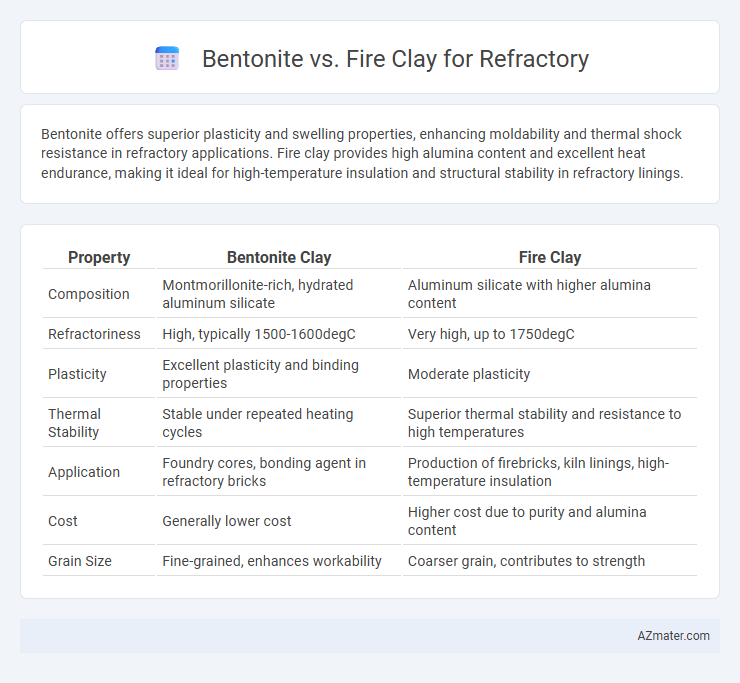Bentonite offers superior plasticity and swelling properties, enhancing moldability and thermal shock resistance in refractory applications. Fire clay provides high alumina content and excellent heat endurance, making it ideal for high-temperature insulation and structural stability in refractory linings.
Table of Comparison
| Property | Bentonite Clay | Fire Clay |
|---|---|---|
| Composition | Montmorillonite-rich, hydrated aluminum silicate | Aluminum silicate with higher alumina content |
| Refractoriness | High, typically 1500-1600degC | Very high, up to 1750degC |
| Plasticity | Excellent plasticity and binding properties | Moderate plasticity |
| Thermal Stability | Stable under repeated heating cycles | Superior thermal stability and resistance to high temperatures |
| Application | Foundry cores, bonding agent in refractory bricks | Production of firebricks, kiln linings, high-temperature insulation |
| Cost | Generally lower cost | Higher cost due to purity and alumina content |
| Grain Size | Fine-grained, enhances workability | Coarser grain, contributes to strength |
Introduction to Refractory Materials
Refractory materials like Bentonite and Fire Clay play crucial roles in high-temperature industrial processes due to their exceptional heat resistance and durability. Bentonite, primarily composed of montmorillonite, offers excellent binding properties and thermal stability, making it ideal for formulating refractory castables and bricks. Fire Clay, rich in alumina and silica, provides superior thermal shock resistance and mechanical strength, essential for lining furnaces, kilns, and other heat-intensive equipment.
What is Bentonite?
Bentonite is a highly absorbent clay composed mainly of montmorillonite, renowned for its exceptional binding properties in refractory applications. Its fine particle size and swelling capacity enable it to act as a crucial binder for fireclay bricks, enhancing green strength and plasticity. In contrast to fire clay, bentonite improves the workability and durability of refractory materials under high-temperature conditions.
Properties of Bentonite in Refractory Applications
Bentonite, a highly absorbent clay primarily composed of montmorillonite, offers exceptional plasticity and swelling properties crucial for binding refractory materials, enhancing their structural integrity under high temperatures. Its superior thermal stability and excellent ion-exchange capacity make it effective in improving the cohesion and thermal resistance of refractory bricks and castables. Compared to fire clay, bentonite provides better moldability and strength retention in high-temperature environments, making it a preferred choice for advanced refractory applications requiring durability and resistance to thermal shock.
What is Fire Clay?
Fire clay is a type of refractory clay known for its high alumina content, typically ranging from 30% to 40%, which imparts excellent resistance to high temperatures and chemical corrosion. It is primarily composed of hydrous aluminum silicates and is widely used in manufacturing fire bricks, insulating materials, and refractory linings for furnaces, kilns, and boilers. Fire clay's natural properties make it highly durable, capable of withstanding temperatures above 1500degC, making it ideal for heavy-duty industrial applications compared to Bentonite, which is primarily valued for its swelling properties and binding ability.
Properties of Fire Clay in Refractory Applications
Fire clay exhibits excellent thermal stability with a refractoriness typically exceeding 1600degC, making it suitable for high-temperature refractory applications. Its low thermal expansion and good mechanical strength enhance durability and resistance to thermal shock in furnaces and kilns. Fire clay's chemical resistance to alkalis and slags further ensures longevity in harsh industrial environments.
Key Differences Between Bentonite and Fire Clay
Bentonite and fire clay are both essential refractory materials, but they differ primarily in composition and thermal properties. Bentonite is a highly absorbent, swelling clay composed mainly of montmorillonite, providing excellent plasticity and bonding capabilities, whereas fire clay contains alumina and silica with superior heat resistance and stability at high temperatures. These variations make bentonite ideal as a binder in refractory bricks while fire clay is preferred for manufacturing heat-resistant kiln linings and bricks that withstand intense thermal cycling.
Thermal Performance Comparison
Bentonite exhibits high thermal stability with a melting point around 1150degC, making it suitable for moderate refractory applications, while fire clay withstands temperatures exceeding 1600degC, offering superior thermal resistance for high-temperature environments. Fire clay's dense alumina-silica composition enhances its thermal shock resistance and dimensional stability under rapid temperature changes compared to bentonite. Bentonite's swelling properties improve plasticity but reduce its effectiveness in extreme thermal conditions where fire clay's robust structure ensures prolonged refractory lifespan.
Cost and Availability
Bentonite offers a cost-effective and widely available option for refractory applications due to its natural abundance and ease of extraction, making it favorable for large-scale industrial use. Fire clay, while generally more expensive and less abundant, provides superior thermal stability and durability in high-temperature environments, justifying the higher cost in specialized refractory linings. The choice between bentonite and fire clay hinges on budget constraints and specific thermal performance requirements within refractory projects.
Common Applications in Industry
Bentonite is widely used in refractory applications as a binder in firebricks and castables, providing excellent plasticity and high-temperature stability, especially in steelmaking and foundry industries. Fire clay, with its high alumina content and thermal resistance, serves as a primary raw material in manufacturing firebricks, kiln linings, and furnace components across glass, cement, and metallurgical sectors. Both materials play crucial roles in enhancing the durability and heat resistance of refractory products critical for high-temperature industrial processes.
Choosing the Right Material for Your Refractory Needs
Bentonite offers excellent plasticity and high binding strength, making it ideal for forming shapes and shapes in refractory applications where molding precision is critical. Fire clay contains higher alumina content, providing superior thermal stability and resistance to high-temperature corrosion, which is essential for linings exposed to intense heat. Selecting between bentonite and fire clay depends on the operating temperature and mechanical stress requirements of your refractory lining to ensure durability and optimal performance.

Infographic: Bentonite vs Fire clay for Refractory
 azmater.com
azmater.com